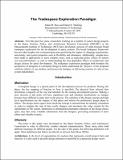| dc.description.abstract | Over the past five years, researchers working on a number of system design projects
in the Space Systems, Policy, and Architecture Research Consortium (SSPARC) at the
Massachusetts Institute of Technology (MIT) have developed a process of value-focused, broad
tradespace exploration for the development of space systems. The broad tradespace framework
has provided insights into communicating and quantifying the impact of changing requirements,
uncertainty, and system properties such as flexibility and robustness. Additionally, insights have
been made in applications to more complex cases, such as analyzing policy effects on system
cost and performance, as well as understanding the time-dependent effects of architecture and
design choices for spiral development. The tradespace exploration paradigm both broadens the
perspective of designers in conceptual design to better understand the “physics” of the proposed
solutions relative to one another, and focuses the designer on delivering systems of value to key
system stakeholders. | en_US |
